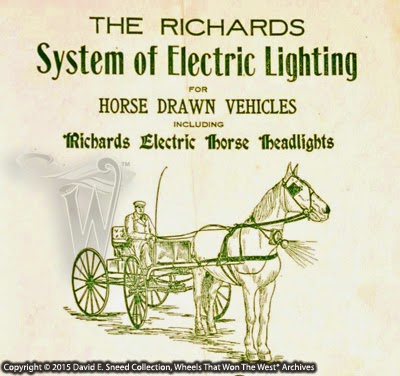Ifyou’ve been following this blog for any length of time, you’ve probably come torealize that it’s anybody’s guess as to what each week’s topic will cover. In fact, if you ask my wife, she’d probablysay that’s just the way my attention deficit mind works; bouncing from one pointto another. The reality is that the overallcategory of western vehicles is so large there’s a world of information rollingaround out there. With that said, Idoubt anyone could have imagined the focus of today’s blog.
Betweenthe travel and extensive amount of research we’re able to pack into each year,I’m fortunate to be able to explore countless early vehicle designs and relatedaccessories. Today’s post, though, maypush the boundaries of what most of us might consider believable. With that teaser as a backdrop, you mightwant to file this one under the “You Gotta Be Kidding Me” segment of horse-drawnvehicle history.
Notlong ago, I was reviewing a century-plus-old sales pamphlet we have in our Archives. It was promoting the “Richards System ofElectric Lighting for Horse Drawn Vehicles.” Sounds basic enough. Upon furtherinspection though, this piece isn’t referring so much to lights positioned onthe vehicle as it is to lights placed on the draft animal. Yep, we’re talking about hanging lights onhorses.
 |
| Proclaimed as “Shadowless, Scientific, and Satisfactory,” this vehicle headlight was worn by the draft animal and promoted by The Richards Horse Headlight Works in Bethel, Connecticut. |
Beforewe snicker too much, these folks did have a good point in that the traditionalmethod of placing lights on the vehicle – behind the horse(s) – did make it toughto always see the terrain ahead with sufficient clarity. According to the sales piece, the answer tothis lack of sight was to move the light ahead of the animal. The biggest challenge to this solution seemsto be the stability of the light as well as the potential for dramatic shadowsto dart back and forth in front of the horse.
Forthose who may be wondering – Yes, this idea was patented! Applied for in the spring of 1906, the patentwas awarded in early 1908 to Mr. E.L. Richards of Litchfield, Connecticut. The introduction of the patent states that…
“…it has been attempted from time totime to provide a means for carrying a lamp so that the rays of light will falldirectly in front of the horse, as for instance by fastening it to the breastcollar or shafts; but it has been found that a very great amount of motion andjarring was imparted to the lamp when carried in such positions.”
Thedescription goes on to proclaim…
“… This device is readily applied to thehorse when occasion may demand, and may be readily removed, and will when inposition fit the neck securely but not uncomfortably, and hold the lamp from vibration...”
 |
| Patented more than a century ago, this “headlight for horses” was designed to provide greater visibility for night time operation of horse drawn vehicles. |
Ultimately,the idea was built on a three-fold premise; it was to be worn by the horse,unobstructed by the horse, and be carried in the “most steady manner.” In spite of what were surely the bestintentions, there’s no evidence that the concept ever caught on. That said, the notion is so unique that anysurviving examples may have trouble being recognized today. Perhaps this post can help someone identifyand preserve another extremely rare – and different – fragment of America’sfirst transportation industry.